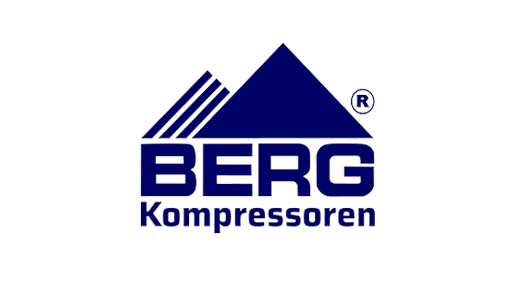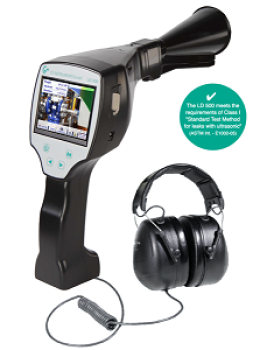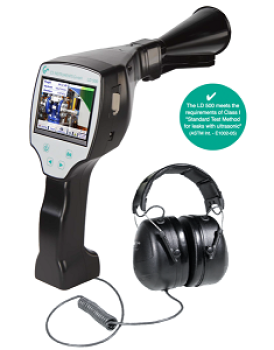Compressed air leakage detection
Measuring devices for leak detection and calculation
Are you aware that leakage drives up the energy costs in production? However, leaks often remain undetected for long periods, as they are invisible and make no noise. Such undetected leaks become real cost drivers. Detecting them helps save money.
Leak detector with camera LD 510
Net €4,045.00
€4,813.55*
Leak detector with camera LD 510
Leak detector with camera – indicates leakage rate in l/min
The new leak meters LD 500/510 with integrated camera and leakage calculation are ideal measuring instruments which help to find and document even smallest leakages (0.1 l/min corresponds to approx. 1 € p. a.) easily even in far distances.
LD 510 is the world’s first leakage meter with an additional freely assignable sensor input for all CS sensors. In addition to leakage measurement and detection, all necessary measurements relating to dew point, flow, pressure, temperature, ... can also be carried out.
Description
Order No.
LD 510 set consisting of:
0601 0106
LD 510 leak detector incl. acoustic trumpet, with integrated camera
and additional input for external sensors, 100 leak tags for marking the
leaks on site
0560 0106
Integrated laser distance measurement
Z554 5000
Transport case
0554 0106
Sound-proof headset
0554 0104
Focus tube with focus tip
0530 0104
AC adapter plug
0554 0009
Spiral cable for connecting the ultrasonic sensor,
length 2m (extended)
020001402
Holster with shoulder strap for LD 500/510
020001795
Special features of leak detector LD 500/LD 510
Find out your leak size (l/min) and potential saving (€/year)
Find the smallest leaks in far distance
Auto level: Auto adapts the sensitivity automatically to the environment and eliminates the ambient noise reliably
Photograph leaking parts
Describe the leak and necessary actions
Transmit the leak details via USB to your desktop software
Create an ISO 50001 report
Seek the leak the whole day (9 hours)
Technical Data Leak detector with camera LD 510
Operating frequency
40 kHz ± 2 kHz
Connections
3.5 mm stereo jack for headset, power supply socket for connecting an external charger
Laser
Wavelength: 645…660 nm
Output power: <1mW(laser class 2)
Power supply
Output voltage: 24 VDC ± 10%
Output current: 120 mA in continuous operation
Display
3.5" touch screen
Interface
USB interface
Data logger
16 GB SD memory card (100 million values)
Power supply
Internal rechargeable Li-Ion batteries, approx. 9 h continuous operation, 4 h charging time
Ambient temperature
0…+50 °C
EMC
DIN EN 61326
Auto level
Automatically adapts the sensitivity to the environment and reliably eliminates ambient noise
Sensitivity
min: 0.1 l/min at 6 bar, 5 m distance, approx. € 1/year of compressed air costs
Weight without headset
540 grams
Technical Data Of External Sensor Input (LD 510 only)
Measuring range:
See external CS sensors
Accuracy:
See external CS sensors
Power supply:
Output voltage: 24 VDC ± 10%
Output current: 120 mA in continuous operation
A leak detector can be used to measure compressed air in a few different ways: Leak Detection: The primary function of a leak detector is to identify and locate leaks in a compressed air system. By using the detector to scan the system, operators can pinpoint areas where air is escaping and quantify the size and severity of the leaks. This measurement can help prioritize repairs and maintenance efforts to minimize energy loss and improve system efficiency. Pressure Drop Measurement: A leak detector can also be used to measure pressure drops within the compressed air system. By comparing pressure readings at different points in the system, operators can identify areas where leaks are causing pressure losses and impacting overall performance. This measurement can help assess the effectiveness of leak repairs and verify system integrity. Air Flow Rate Calculation: Some advanced leak detectors may have the capability to calculate the flow rate of air escaping from leaks in the system. By measuring the rate of air leakage, operators can estimate the volume of compressed air wasted due to leaks and quantify the associated energy costs. This measurement can help justify investments in leak detection and repair initiatives by demonstrating potential savings.
Overall, using a leak detector to measure compressed air can provide valuable insights into the performance and efficiency of the system. By quantifying leaks, pressure drops, and air flow rates, operators can make informed decisions to optimize their compressed air systems, reduce energy consumption, and improve overall productivity.
Downloads
Data sheet LD 500/510, PDF (Size: 2.1 MB)
Short manual LD 500, PDF (Siza:1 MB)
Suitable sensors - portable for LD 510, PDF (Size: 1.4 MB)
Instruction manual LD 500, PDF (Size: 2.5 MB)
Instruction manual CS Leak Reporter, PDF (Size: 1.6 MB)
Leak detector with camera LD 500
Net €3,780.00
€4,498.20*
Leak detector with camera LD 500
Leak detector with camera – indicates leakage rate in l/min
The new leak meters LD 500/510 with integrated camera and leakage calculation are ideal measuring instruments which help to find and document even smallest leakages (0.1 l/min corresponds to approx. 1 € p. a.) easily even in far distances.
The detection of compressed air and gas leaks can be more or less problematic depending on the accessibility of the systems. We therefore offer special accessories for our LD 500/510 leak detectors to facilitate leak detection in difficult-to-access areas.
These include, for example, a special acoustic trumpet, a focus tube with focus tip, the so-called flexible "gooseneck" and a parabolic mirror. For more information please see also the additional product images on the left.
Special features of leak detector LD 500/LD 510
Find out your leak size (l/min) and potential saving (€/year)
Find the smallest leaks in far distance
Auto level: Auto adapts the sensitivity automatically to the environment and eliminates the ambient noise reliably
Photograph leaking parts
Describe the leak and necessary actions
Transmit the leak details via USB to your desktop software
Create an ISO 50001 report
Seek the leak the whole day (9 hours)
Technical Data Leak detector with camera LD 500
Operating frequency
40 kHz ± 2 kHz
Connections
3.5 mm stereo jack for headset, power supply socket for connecting an external charger
Laser
Wavelength: 645…660 nm
Output power: <1mW(laser class 2)
Display
3.5" touch screen
Interface
USB interface
Data logger
16 GB SD memory card (100 million values)
Power supply
Internal rechargeable Li-Ion batteries, approx. 9 h continuous operation, 4 h charging time
Ambient temperature
0…+50 °C
EMC
DIN EN 61326
Auto level
Automatically adapts the sensitivity to the environment and reliably eliminates ambient noise
Sensitivity
min: 0.1 l/min at 6 bar, 5 m distance, approx. € 1/year of compressed air costs
Weight without headset
540 grams
Intended use
The LD 500 is a leak detector for quick and reliable leak detection in/on compressed air systems.The LD500 leak detector evaluates the ultrasonic waves generated by the leakage based on distance and pressure.It is solely designed and constructed for the intended use described here and may only be used for this purpose.The user must verify that the device is suitable for the intended use. The technical data listed in this datasheet are binding.Improper handling or operation outside the technical specifications is not permitted. Claims of any kind for damages arising from improper use are excluded.
A leak detector can indirectly affect the temperature of compressed air by impacting the overall efficiency and performance of the compressed air system. Here's how:Energy Loss: Leaks in a compressed air system can result in energy loss as the compressor has to work harder to maintain the desired pressure levels. This increased workload can lead to higher energy consumption and, in turn, generate more heat within the compressor and the compressed air system. Increased Heat Generation: As the compressor works harder to compensate for leaks, it generates more heat during the compression process. This additional heat can raise the temperature of the compressed air as it moves through the system, potentially affecting downstream equipment or processes that rely on cooler air. Inefficient Cooling: Leaks can also disrupt the cooling mechanisms within the compressed air system, such as aftercoolers or intercoolers, which are designed to remove heat from the compressed air. When leaks are present, these cooling systems may not function optimally, leading to higher compressed air temperatures. Reduced Efficiency: Leaks can cause pressure drops within the system, requiring the compressor to run longer or more frequently to maintain the desired pressure levels. This increased operation time can contribute to higher heat generation and, ultimately, impact the overall efficiency of the compressed air system.
By using a leak detector to identify and address leaks in the compressed air system, operators can help minimize energy loss, reduce heat generation, and optimize the system's performance. This proactive approach can help maintain the temperature of the compressed air within acceptable limits and ensure that downstream equipment and processes receive the required quality of air for optimal performance.
Downloads
Data sheet LD 500/510, PDF (Size: 2.1 MB)
Short manual LD 500, PDF (Siza:1 MB)
Suitable sensors - portable for LD 510, PDF (Size: 1.4 MB)
Instruction manual LD 500, PDF (Size: 2.5 MB)
Instruction manual CS Leak Reporter, PDF (Size: 1.6 MB)
leakage Detection Functional principle:
Leaks are points in the compressed air system where air can escape. As this results in a pressure drop, more energy is needed to keep the pressure in your system at the required level. Leaks generally occur in
lines, connections, maintenance components and quick-release couplings far away from the compressor.
As compressed air escapes, the gas molecules cause friction along the piping wall. This friction in turn generates a noise in the ultrasonic frequency range.
Leaks are points in the compressed air system where air can escape. As this results in a pressure drop, more energy is needed to keep the pressure in your system at the required level. Leaks generally occur in
lines, connections, maintenance components and quick-release couplings far away from the compressor.
As compressed air escapes, the gas molecules cause friction along the piping wall. This friction in turn generates a noise in the ultrasonic frequency range.


